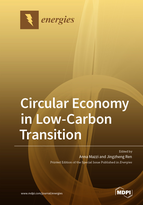Circular Economy in Low-Carbon Transition
A special issue of Energies (ISSN 1996-1073). This special issue belongs to the section "C: Energy Economics and Policy".
Deadline for manuscript submissions: closed (25 October 2021) | Viewed by 34460
Special Issue Editors
Interests: sustainability performance indicators; quality environment health and safety management systems; life cycle assessment; environmental footprint; circular economy; sustainable tourism; sustainable territorial management
2. Department of Industrial and Systems Engineering, The Hong Kong Polytechnic University, Hong Kong, China
Interests: process system engineering; sustainability engineering; engineering operations management; artificial intelligence; process simulation, integration and optimization; multi-criteria decision analysis
Special Issues, Collections and Topics in MDPI journals
Special Issue Information
Dear Colleagues,
It is my great pleasure to invite you to submit your most recent research to this Special Issue “Circular economy in low-carbon transition”.
The circular economy represents a fundamental pillar for modern business models and sustainable development targets: the mandatory claim “reduce, reuse, recycle” is the answer to the global challenge of natural resource depletion and waste increase. At the same time, energy production and consumption play a key role in the face of challenges of industrialization and rapid population growth: with the depletion of traditional fossil fuels, renewable and low-carbon energy sources have attracted more and more attention for their advantages such as high renewability, great development potential, and potential emissions-mitigation. However, to implement the circular economy and low-carbon transition, the choices that shift the environmental burdens rather than reduce them must be carefully avoided, using a life cycle approach. The international community – including scientists, policymakers, industries, and markets – must develop new tools and competencies to generate environmental and socio-economic values from a comprehensive perspective.
This Special Issue will outline a roadmap of circular economy in the low-carbon transition, through the exchange of experiences in different contexts with both environmental and socio-economic points of view. Qualitative and quantitative measurements in resources/energy utilization, multi-criteria impact assessment in energy systems, and closing the loop strategies and initiatives represent valuable contributions for this Special Issue.
In particular, we encourage submissions of research articles, case studies, and review articles related but not limited to the following:
- Policies and metrics to support a circular economy and low-carbon transition
- Behavior and market analysis in a circular economy and low-carbon transition
- Multi-criteria analysis of energy systems
- Multi-criteria analysis of reuse/recycle processes
- Strategies and experiences for energy efficiency
- Risks/benefits analysis of second/third raw materials
- Opportunities and obstacles in a circular economy and low-carbon transition
Prof. Dr. Jingzheng Ren
Guest Editors
Manuscript Submission Information
Manuscripts should be submitted online at www.mdpi.com by registering and logging in to this website. Once you are registered, click here to go to the submission form. Manuscripts can be submitted until the deadline. All submissions that pass pre-check are peer-reviewed. Accepted papers will be published continuously in the journal (as soon as accepted) and will be listed together on the special issue website. Research articles, review articles as well as short communications are invited. For planned papers, a title and short abstract (about 100 words) can be sent to the Editorial Office for announcement on this website.
Submitted manuscripts should not have been published previously, nor be under consideration for publication elsewhere (except conference proceedings papers). All manuscripts are thoroughly refereed through a single-blind peer-review process. A guide for authors and other relevant information for submission of manuscripts is available on the Instructions for Authors page. Energies is an international peer-reviewed open access semimonthly journal published by MDPI.
Please visit the Instructions for Authors page before submitting a manuscript. The Article Processing Charge (APC) for publication in this open access journal is 2600 CHF (Swiss Francs). Submitted papers should be well formatted and use good English. Authors may use MDPI's English editing service prior to publication or during author revisions.
Keywords
- Circular economy
- Low-carbon energy sources
- Waste-to-energy
- Renewable energy production
- Energy efficiency
- System optimization
- Energy management
- Life cycle assessment
- Life cycle costing
- Social life cycle assessment
- Life cycle sustainability assessment
- Environmental impact assessment
- Multi-criteria analysis
- Material flow analysis
- Consumers behavior analysis
- Market analysis
- Reduce, reuse, recycling
- End-of-waste
- Collaborative supply chain
- Easy-to-repair design







